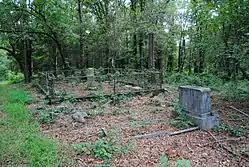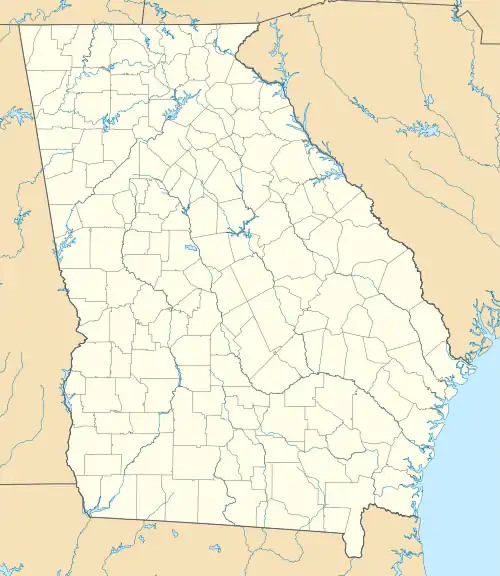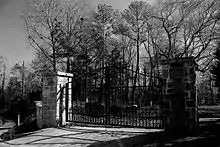Gospel Pilgrim Cemetery
Gospel Pilgrim Cemetery was founded in 1882 as a cemetery for African Americans[2] in the 216th general militia district, Athens, Georgia area.[3] Nine acres in size, it contains an estimated 3,500, mostly unmarked, graves.[4]
Gospel Pilgrim Cemetery | |
 Morton Family Plot in the Gospel Pilgrim Cemetery | |
  | |
| Location | 530 Fourth Street Athens, Georgia |
|---|---|
| Coordinates | 33°58′10.79″N 83°21′41.99″W |
| Area | 10.1 acres (4.1 ha) |
| Built | 1882 |
| Website | www.gospelpilgrimcemetery.com |
| NRHP reference No. | 06000285[1] |
| Added to NRHP | April 19, 2006 |
The Gospel Pilgrim Society founded the cemetery and was "a social and charitable burial insurance organization".[5] The site was listed on the National Register of Historic Places in 2006.[6]
The University of Georgia's New Media Institute hoped to attract visitors to the site and set up a local phone number that visitors could dial to hear descriptions of the cemetery's history and commentary by Rev. Archibald Killian, a local expert on black history.[7]
Gospel Pilgrim Society
Social and charitable lodges became very popular during the period after the Civil War. By 1912, the African-American community had eight orders - including the Gospel Pilgrims - with a total of 29 lodges in Athens, Georgia. The membership of these lodges totaled about 2,500 people that year, "or about 75 percent of the adult black population of Athens".[8] The origin of the name, "Gospel Pilgrim", is unknown.[9][10]
Cemetery
In 1882, the Gospel Pilgrim Society purchased 8.25 acres from the estate of William P. Talmadge. He was a white blacksmith; his widow and executrix, Elizabeth Talmadge sold the property for $238.50. The deed lists the probably illiterate laborer, Green Bullock, as the president of the society at the time of the sale. In 1902, the society purchased an additional 0.75 acres from George P. Brightwell. Finally, in 1905, a 100'x60' parcel was transferred to neighboring Springfield Baptist Church to give the cemetery its current dimensions, bordering Fourth Street and what is now the Seaboard Airline Railway.[11][12] A 2004 survey found the acreage to be 10.071 acres, slightly larger than given in the deeds.[13]
The earliest burials date from 1885, and most of those are from the family of Monroe B. Morton[14] a successful contractor, property owner, newspaper publisher, and developer whose Morton Building in Athens included the Morton Theater and offices for African American professionals. Other smaller cemeteries for African Americans were associated with churches throughout the county, but Gospel Pilgrim was "Athens' first major cemetery controlled by African Americans."[15] Burials were performed there regularly until the 1960s,[14] with the peak decade being the 1940s.[16] and the cemetery fell into disuse and disrepair, probably due to lack of funding; the last burial took place in 2003.[14]
Athens-Clarke County hired attorney Jim Warnes to do a title search on the property; he found no owner, and in 2002, the cemetery "was declared an abandoned property".[17] Warnes did find a Georgia law "which allows local governments to use local funds to care for abandoned property without the local government assuming ownership or responsibility."[18]
Restoration efforts
In 2007, Athens-Clarke County designated $350,170 for rehabilitation efforts. The restoration project was completed on October 13, 2008. In 2009, the project received an Outstanding Achievement Award from the Athens-Clarke Heritage Foundation and an Excellence in Rehabilitation Award from the Georgia Trust for Historic Preservation.[19]
Notable burials

- Madison Davis, who, along with Alfred Richardson, was one of two black, former slave, state legislators from Clarke County during Reconstruction.[20] It is worth noting that, "[r]umor has it that Richardson is buried" there, "[b]ut no marked grave has been found for him... Fellow legislator Madison Davis is buried in Gospel Pilgrim with a fine headstone."[21]
- Monroe Bowers "Pink" Morton, who built the Morton Theatre[20][22]
- Harriet Powers, former enslaved person, folk artist, quilt maker; grave rediscovered in 2005[23][24]
Notes
- National Register of Historic Places
- Official website
- Weeks, 1999
- Hester, 2012
- Athens Convention and Visitors Bureau
- NRHP in Clarke County, Georgia
- Diverse: Issues in Higher Education
- Thurmond, 2000, 44
- Hester, February 2004, 11
- Hester, Fall 2004, 36
- Hester, February 2004, 14
- Hester, Fall 2004, 33-36
- NRHP form
- East Athens Development Corporation
- Hester, Fall 2004, 38-39
- Hester, February 2004, 20
- Hester, February 2004, 33
- Hester, Fall 2004, 42
- "Project 24: Gospel Pilgrim Cemetery | Athens-Clarke County, GA - Official Website". athensclarkecounty.com. Retrieved 2017-04-04.
- Gospel Pilgrim Cemetery interments
- Hester, 2010, 128
- Morton Theatre
- Ulrich, 2011
- Callahan, 2009
References
- "AthensHeritage Walks: Gospel Pilgrim Cemetery National Register District". Athens Convention & Visitors Bureau. Archived from the original on 12 November 2014. Retrieved 12 November 2014.
- Callahan, Ashley (2009). A Colorful Past: Decorative Arts of Georgia: the Fourth Henry D. Green Symposium of the Decorative Arts. Georgia Museum of Art, University of Georgia. p. 50. ISBN 9780915977727.
- "University of Georgia Pushes 'Stranger Technology' To Attract New Breed of Tourists". Diverse: Issues in Higher Education. 23 (12): 22. 2006. ISSN 0742-0277.
- "History". East Athens Development Corporation. Retrieved 12 November 2014.
- "Official page". Retrieved 12 November 2014.
- "Prominent African-Americans". Gospel Pilgrim Cemetery. Retrieved 13 November 2014.
- Hester, Albert L. (February 2004). Gospel Pilgrim Cemetery: An African-American Historic Site. Athens, GA: Green Berry Press. OCLC 262742754.
- Hester, Al (Fall 2004). "Gospel Pilgrim Cemetery: A Rich Resource in African-American History". Athens Historian. Athens, GA: Athens Historical Society. 9: 34–43. OCLC 36821172.
- Hester, Albert Lee (2010). Enduring Legacy: Clarke County Georgia's Ex-Slave Legislators Madison Davis and Alfred Richardson. Athens, GA: Green Berry Press. ISBN 9780967302782.
- Hester, Al (24 October 2012). "Slaves Buried in Gospel Pilgrim Cemetery, Athens, Georgia". Al Hester's Blog. Retrieved 12 November 2014.
- "Pink Morton". The Morton Theatre. Athens-Clarke County's Leisure Services Department Arts Division. Retrieved 13 November 2014.
- "National Register Information System". National Register of Historic Places. National Park Service. July 9, 2010.
- "National Register of Historic Places in Clarke County, Georgia". Retrieved 12 November 2014.
- Luce, W. Ray (Historic Preservation Division Director). "National Register of Historic Places Registration Form". Retrieved 14 November 2014.
- Thurmond, Michael L. (October 2000). "The Black Church: Not By Faith Alone". Athens Historian. Athens, GA: Athens Historical Society. 5 (1): 37–47. OCLC 36821172.
- Ulrich, Laurel Thatcher (2011). "'A Quilt Unlike Any Other': Rediscovering the Work of Harriet Powers". In Elizabeth Anne Payne (ed.). Writing Women's History: A Tribute to Anne Firor Scott. UP of Mississippi. pp. 82–116. ISBN 9781617031748. Retrieved 12 November 2014.
- Weeks, Eve B., ed. (1999). Athens-Clarke County, Georgia Cemeteries. Athens, GA: Athens Historical Society. pp. 45–48. OCLC 40937597.
- "Project 24: Gospel Pilgrim Cemetery". Athens-Clarke County Unified Government. SPLOST Project 24. Retrieved 3 April 2017.